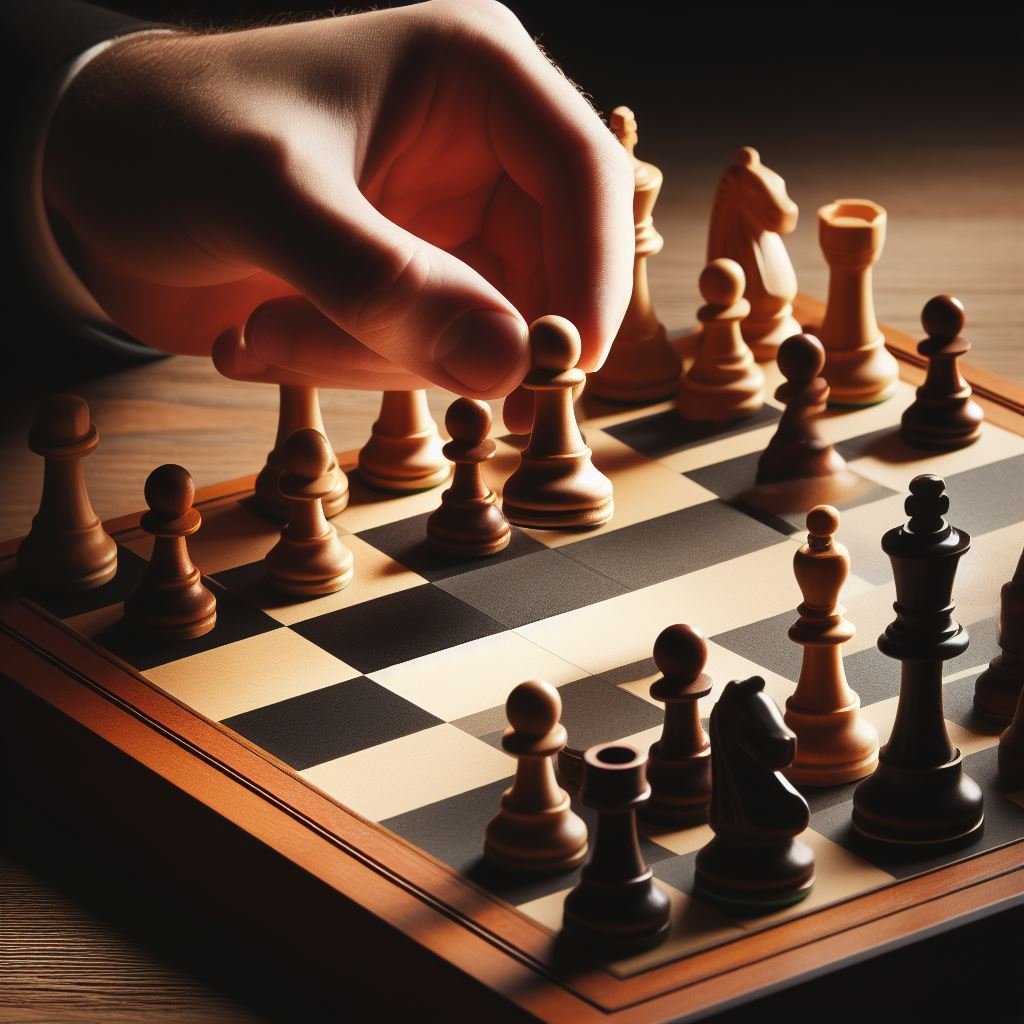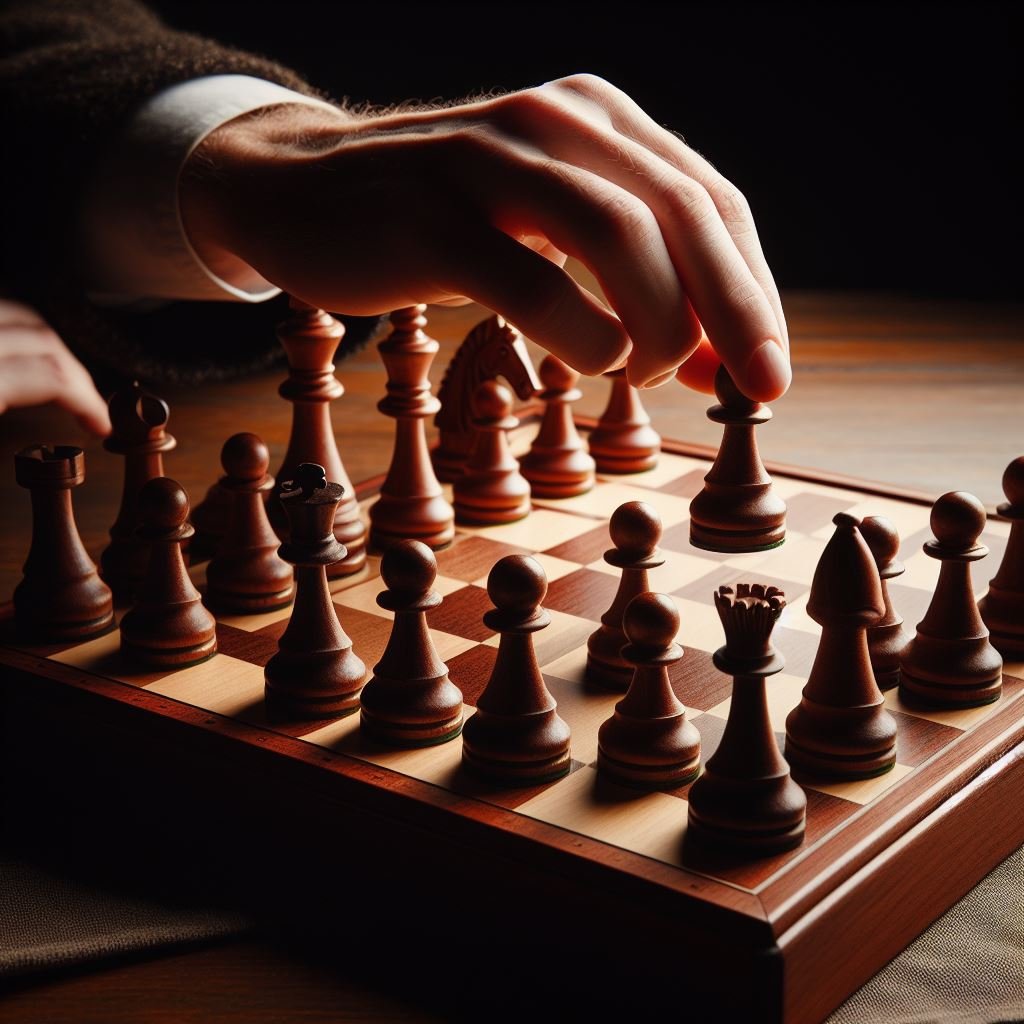Chess Game:
Chess is a two-player strategy board game that is played on an 8×8 grid known as a chessboard. Each player controls an army of pieces, consisting of different types with unique movement abilities. The objective of the game is to checkmate the opponent’s king, which means putting the opponent’s king in a position where it is under attack and cannot escape capture.
The chessboard consists of 64 squares, alternating in color between light and dark. Each player begins the game with 16 pieces:
- King: The most important piece, which must be protected at all costs. If the king is in a position to be captured, the game is lost.
- Queen: The most powerful piece, capable of moving any number of squares in any direction (horizontally, vertically, or diagonally).
- Rooks: Also known as castles, rooks can move any number of squares horizontally or vertically.
- Bishops: Bishops can move any number of squares diagonally.
- Knights: Knights move in an L-shape, consisting of two squares in one direction and then one square perpendicular to it (or vice versa).
- Pawns: Pawns move forward one square at a time, but they capture diagonally. On their first move, pawns have the option to move forward two squares.
Players take turns moving their pieces across the board, with the goal of controlling the center, developing pieces, and creating threats against the opponent’s pieces. The game can be won through various means, including checkmate, stalemate (when a player’s king is not in check but has no legal moves), or resignation.
Chess is renowned for its depth, complexity, and strategic richness, making it one of the most popular and enduring games in the world. It has a rich history dating back over a millennium and is played by millions of people of all ages and skill levels around the globe.

Chess Game:
To play the game of chess, follow these basic rules:
- Setup: Place the chessboard between the two players so that each player has a light-colored square at the bottom right corner. Arrange the pieces on the board as follows:
- Each player has one king, one queen, two rooks, two knights, two bishops, and eight pawns.
- Place the rooks on the corners, the knights next to them, then the bishops, with the queen placed on her own color square, and the king next to her.
- Pawns are placed on the second row (for White) and seventh row (for Black).
- Movement: Each type of piece moves differently:
- Kings can move one square in any direction (horizontally, vertically, or diagonally).
- Queens can move any number of squares in any direction (horizontally, vertically, or diagonally).
- Rooks can move any number of squares horizontally or vertically.
- Bishops can move any number of squares diagonally.
- Knights move in an L-shape: two squares in one direction (horizontally or vertically) and then one square perpendicular to that direction.
- Pawns move forward one square at a time, but they have the option to move forward two squares on their first move. Pawns capture diagonally.
- Objective: The goal of chess is to checkmate the opponent’s king. Checkmate occurs when the opponent’s king is in a position to be captured (in check) and there is no legal move that can be made to escape the threat.
- Turns: Players take turns moving their pieces across the board. White always moves first, and then players alternate turns.
- Special Moves:
- Castling: This move allows the king and one rook to move simultaneously. It is the only move in chess where two pieces are moved at once. Castling is done by moving the king two squares towards a rook, and then placing the rook on the opposite side of the king. However, there are certain conditions that must be met in order to castle.
- En passant: This move can only be made by pawns. When a pawn advances two squares from its starting position and lands next to an opponent’s pawn, the opponent has the option to capture the pawn “en passant” by moving their pawn diagonally to the square the other pawn skipped over.
- Promotion: When a pawn reaches the opposite side of the board, it can be promoted to any other piece (except a king) of the player’s choice (usually a queen).
- Check and Checkmate: When a player’s king is under threat of capture by the opponent’s pieces, it is said to be in check. The player must make a move to get out of check, either by moving the king, capturing the threatening piece, or blocking the check with another piece. If a player’s king is in check and there is no legal move to get out of check, it is checkmate, and the game is over.
These are the basic rules of chess to get started. As you play more games and gain experience, you will learn more advanced strategies and tactics.

Chess Game:
Making money playing chess can be challenging, as it is not typically a high-paying profession compared to other competitive activities. However, there are several ways you can potentially earn income through chess:
- Tournaments: Participating in chess tournaments can offer prize money for top finishers. Major tournaments, such as national championships or international events, may have significant prize pools. However, competition can be fierce, and success in tournaments often requires years of dedicated practice and study.
- Coaching: Skilled chess players can offer coaching services to beginners or less experienced players. Coaching can be done one-on-one, in group settings, or online through platforms like chess.com or lichess.org. Coaches may charge hourly rates or monthly fees for their services.
- Teaching: Teaching chess in schools, community centers, or private academies can be another way to earn income. Many educational institutions offer chess programs or clubs, and qualified instructors are often in demand to teach students of all ages.
- Streaming and Content Creation: Streaming chess games on platforms like Twitch or YouTube can attract viewers and potential subscribers or donors. Some successful chess streamers earn income through ad revenue, sponsorships, and viewer donations. Creating educational content such as tutorials, analysis videos, or written articles can also generate income through advertising or subscriptions.
- Simultaneous Exhibitions: Experienced players may offer simultaneous exhibitions, where they play multiple games at once against multiple opponents. Participants typically pay a fee to participate, and successful exhibitions can generate income for the player.
- Chess Products and Merchandise: Chess players with a strong following or brand may be able to monetize their popularity by selling merchandise such as chess sets, apparel, or instructional materials. Building a personal brand through social media, blogs, or other platforms can help attract customers and fans.
- Sponsorships and Endorsements: Top chess players may attract sponsorships or endorsements from chess-related companies, brands, or organizations. Sponsorships can provide financial support, equipment, or travel expenses in exchange for promoting the sponsor’s products or services.
- Simultaneous Exhibitions: Some chess players, especially those with a high rating or strong reputation, may offer simultaneous exhibitions, where they play multiple games at once against multiple opponents. Participants typically pay a fee to participate, and successful exhibitions can generate income for the player.
While it is possible to make money playing chess, it often requires a combination of skill, dedication, networking, and entrepreneurial spirit. Additionally, success in the chess world can be unpredictable, and income may vary depending on factors such as tournament results, coaching demand, or the popularity of streaming content.

Chess Game:
Playing chess can offer numerous benefits to individuals and society as a whole. Some of the key benefits of playing chess include:
- Cognitive Development: Chess is a mentally stimulating game that requires critical thinking, problem-solving, and strategic planning. Regularly engaging in chess can help improve cognitive abilities such as memory, concentration, pattern recognition, and decision-making skills.
- Academic Performance: Research has shown that students who play chess tend to perform better academically, particularly in mathematics and reading comprehension. Chess helps develop analytical thinking and logical reasoning abilities, which can translate into improved academic performance across various subjects.
- Life Skills: Chess teaches valuable life skills such as patience, perseverance, sportsmanship, and resilience. Players learn to handle setbacks and mistakes gracefully, as well as to think creatively and adaptively in challenging situations.
- Social Interaction: Chess is a social game that fosters interaction and communication between players. Whether played in person or online, chess provides opportunities for socialization, collaboration, and friendly competition, helping to build friendships and strengthen community bonds.
- Stress Reduction: Engaging in chess can provide a relaxing and enjoyable way to unwind and de-stress. Immersing oneself in the strategic complexities of the game can help distract from everyday worries and promote mental well-being.
- Cross-Cultural Exchange: Chess is a universal game that transcends cultural and linguistic barriers, making it an ideal tool for promoting cross-cultural understanding and exchange. Players from diverse backgrounds can come together to play and appreciate the game, fostering mutual respect and appreciation for different perspectives.
- Personal Growth: Chess offers opportunities for personal growth and self-improvement. Whether played casually for leisure or competitively in tournaments, chess challenges individuals to continually learn, adapt, and strive for mastery, fostering a growth mindset and a sense of achievement.
- Community Building: Chess communities, both local and global, provide a supportive and inclusive environment for players of all ages and skill levels to come together and share their passion for the game. Participating in chess clubs, events, and online forums can create a sense of belonging and camaraderie among enthusiasts.
Overall, the benefits of playing chess extend far beyond the game itself, enriching individuals’ lives and contributing to the social, educational, and cultural fabric of society. Whether played for leisure, education, or competition, chess remains a timeless pursuit that continues to captivate and inspire people around the world.

Chess Game:
Playing chess offers numerous advantages, but there are also some potential disadvantages to consider:
Advantages:
- Cognitive Development: Chess requires critical thinking, problem-solving, and strategic planning, which can enhance cognitive abilities such as memory, concentration, and decision-making skills.
- Academic Performance: Research suggests that playing chess can improve academic performance, particularly in areas such as mathematics and reading comprehension, by developing analytical thinking and logical reasoning abilities.
- Life Skills: Chess teaches valuable life skills such as patience, perseverance, sportsmanship, and resilience. Players learn to handle setbacks and mistakes gracefully, as well as to think creatively and adaptively in challenging situations.
- Social Interaction: Chess is a social game that fosters interaction and communication between players. Whether played in person or online, chess provides opportunities for socialization, collaboration, and friendly competition, helping to build friendships and strengthen community bonds.
- Stress Reduction: Engaging in chess can provide a relaxing and enjoyable way to unwind and de-stress. Immersing oneself in the strategic complexities of the game can help distract from everyday worries and promote mental well-being.
Disadvantages:
- Time Commitment: Chess can be a time-consuming activity, particularly for serious players who participate in tournaments or competitive play. Learning and mastering the game requires dedication and practice, which may detract from other activities or responsibilities.
- Frustration and Burnout: Chess can be mentally challenging and emotionally demanding, leading to frustration or burnout, particularly for players who set high expectations or experience setbacks. The pressure to perform well in tournaments or competitions can also contribute to stress and anxiety.
- Isolation: While chess can be a social game, particularly when played in clubs or with friends, it can also be a solitary pursuit, particularly for players who prefer to practice or study alone. Excessive isolation may lead to feelings of loneliness or social withdrawal.
- Perfectionism: Chess is a game of skill and strategy, and some players may develop perfectionistic tendencies, striving for flawless play or obsessing over mistakes. Perfectionism can lead to self-criticism, anxiety, and unrealistic expectations, detracting from the enjoyment of the game.
- Physical Inactivity: Chess is a sedentary activity that involves minimal physical movement. Prolonged periods of sitting and focusing on the game may contribute to a sedentary lifestyle and associated health risks such as obesity, cardiovascular disease, and musculoskeletal problems.
Overall, while playing chess offers numerous benefits for cognitive, social, and emotional development, it is important for players to be mindful of potential drawbacks and to strike a balance between enjoyment and well-being. By practicing moderation, setting realistic goals, and prioritizing self-care, players can derive the maximum benefits from their chess experience while minimizing potential risks.

Chess Game:
To play chess well and improve your chances of winning matches, several types of training and key considerations are essential:
- Learn the Rules: Start by understanding the rules of chess thoroughly. Learn how each piece moves, how to set up the board correctly, and the basic objectives of the game.
- Study Basic Tactics: Familiarize yourself with fundamental chess tactics such as forks, pins, skewers, discovered attacks, and double attacks. Understanding these tactical motifs will help you capitalize on opportunities and avoid falling into traps.
- Develop Opening Knowledge: Study common chess openings and their associated strategies. Focus on learning principles of opening play, such as controlling the center, developing pieces, and ensuring king safety. Begin with a few openings that suit your style and preferences, and gradually expand your repertoire over time.
- Practice Endgame Techniques: Mastering basic endgame principles is crucial for converting advantages into wins and salvaging drawn positions. Learn essential endgame concepts such as pawn promotion, king and pawn endings, rook endings, and basic checkmate patterns.
- Analyze Master Games: Study games played by grandmasters and top-level players to gain insight into strategic planning, positional play, and tactical combinations. Analyze the thought processes behind each move and try to understand the reasoning behind strategic decisions.
- Solve Chess Puzzles: Regularly solve chess puzzles and tactical exercises to sharpen your calculation skills, improve pattern recognition, and reinforce tactical motifs. Chess puzzles are an effective way to practice visualization and develop tactical awareness.
- Play Regularly: Practice playing games regularly, both against human opponents and computer engines. Online chess platforms offer opportunities to play against opponents of varying skill levels and to analyze your games afterward using computer analysis tools.
- Review Your Games: Analyze your games critically to identify strengths, weaknesses, and areas for improvement. Look for patterns in your play, common mistakes, and missed opportunities. Learn from your mistakes and strive to avoid repeating them in future games.
- Seek Feedback and Guidance: Seek feedback from stronger players, coaches, or mentors to help identify areas for improvement and receive guidance on strategic planning, tactical awareness, and overall game strategy.
- Stay Patient and Persistent: Improvement in chess takes time, patience, and dedication. Be prepared to invest time and effort into your training regimen, and don’t be discouraged by setbacks or losses. Stay persistent, maintain a positive attitude, and focus on continuous learning and improvement.
By following these training strategies and keeping these key considerations in mind, you can enhance your chess skills, increase your chances of winning matches, and enjoy greater success in your chess endeavors.

Thanks for sharing. I read many of your blog posts, cool, your blog is very good.
Thanks for sharing. I read many of your blog posts, cool, your blog is very good.
Your article helped me a lot, is there any more related content? Thanks!